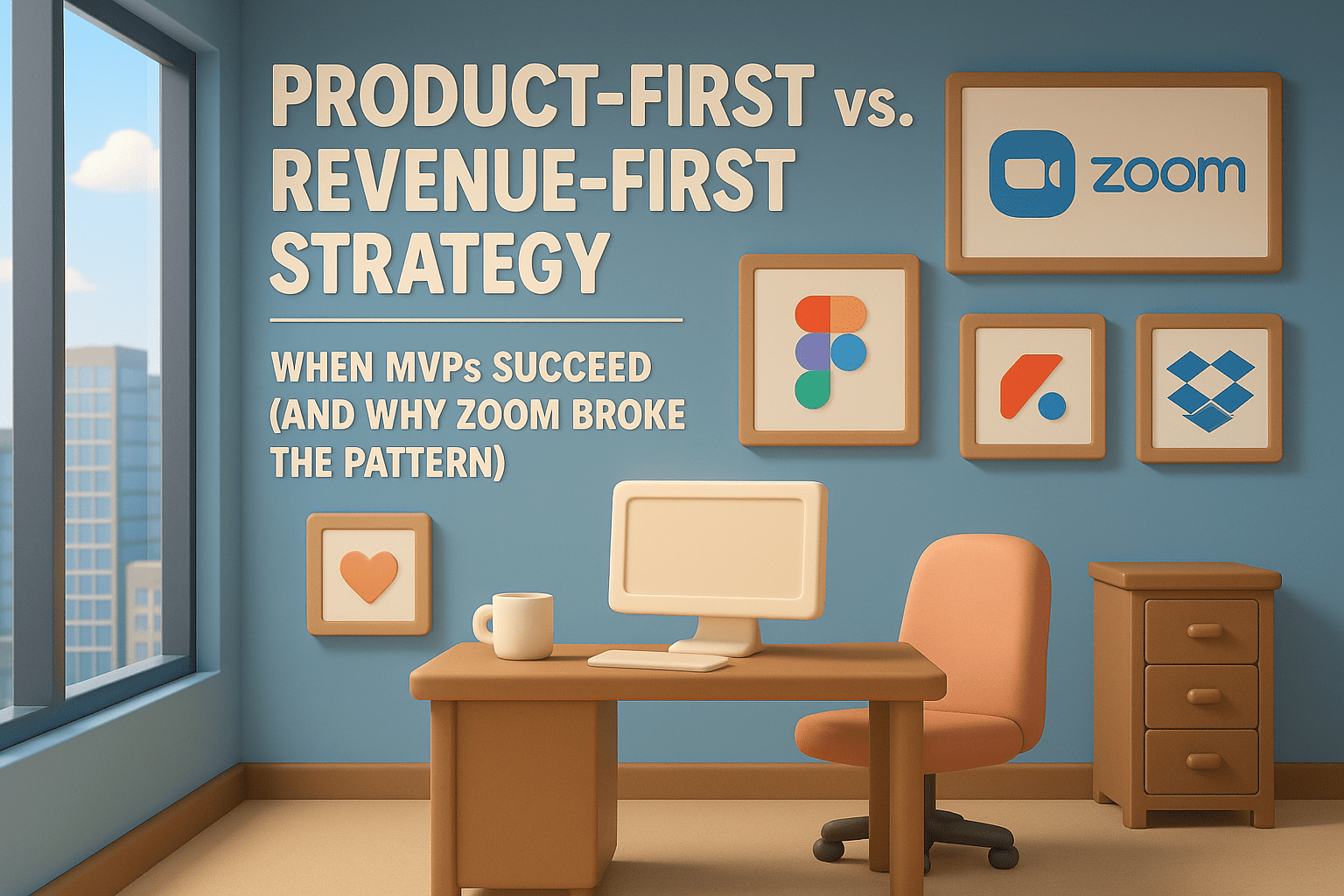Product-First vs. Revenue-First Strategy: When MVPs Succeed (and Why Zoom Broke the Pattern)
Evidence shows product-first startups survive 2.5× more often. Learn why Figma, Dropbox and MoniePoint succeeded with MVPs, and why Zoom’s revenue-first approach required unique conditions.
Core Strategic Difference
Product-first strategy solves user problems before monetization. Revenue-first strategy seeks immediate income without product validation. Research shows product-first startups survive 2.5 times more often because they prioritize genuine need over financial vanity metrics.
Why Revenue-First Approaches Fail
Premature monetization creates fatal blind spots:
Quibi generated revenue but ignored mobile usability complaints, losing 90% of users in three months
Theranos announced partnership revenues while concealing non-functional technology
Juicero’s $400 press addressed no consumer pain point
Critical insight: Early payments test transaction mechanics, not product value. Revenue-first founders often misinterpret initial sales as validation while ignoring retention failures.
MVP Success Cases: Product-First Wins
1. Solve real problems → Build trust
Figma offered browser-based design collaboration when Adobe charged $50/month for desktop-only tools. This solved remote team frustrations, creating evangelists who fueled organic growth to 4 million users.
MoniePoint engineered solar-powered POS terminals specifically for Nigerian markets with three-hour daily electricity. Reliability in extreme conditions established trust, processing ₦22B monthly from rural users competitors ignored.
2. Feedback loops → Create advocates
Dropbox’s demo video attracted 75,000 sign-ups without a working product by exposing file-syncing frustrations. User feedback directly shaped development priorities.
PiggyVest digitized Nigeria’s traditional “esusu” savings circles. Automated collection features built through user input drove ₦2T savings by 5 million users who promoted the platform.
3. Efficient resources → Drive innovation
Tesla’s Roadster provided real-world battery performance data through early adopters. This guided critical improvements for Model 3’s mass-market success.
Spotify’s invite-only European beta revealed unexpected behaviors like playlist sharing. Infrastructure scaled using these insights, achieving 70% paid retention at scale.
Zoom: The Revenue-First Exception
Why Zoom succeeded against the pattern:
| Factor | Zoom’s Approach | Why Others Fail |
|---|---|---|
| Market entry | Targeted proven WebEx pain points | Solve hypothetical problems |
| Monetization | 40-minute group call limit created upgrade urgency | Unlimited free access |
| Infrastructure | $146M pre-IPO investment supported 300M+ users | Scaling failures under load |
| External catalyst | Pandemic forced enterprise adoption | No market-disrupting event |
Unrepeatable conditions:
Founder Eric Yuan’s 14 years at WebEx provided unmatched domain expertise
The 2020 pandemic caused 1,900% demand surge impossible to replicate
Current growth stabilized at 3% post-pandemic
When Revenue-First Works
Revenue-first only succeeds under specific conditions:
Documented problems: Zoom targeted enterprise frustrations verified through Cisco’s existing user base
Product-transaction alignment: Stripe’s API directly processes payments – usage equals revenue
Paid-tier necessity: GitHub required subscriptions to fund private repository security
Actionable Strategy Framework
| Scenario | Approach | Critical Actions |
|---|---|---|
| Unproven market | MVP-first | Conduct user interviews before coding |
| Validated enterprise pain | Revenue-first | Secure SOC 2 compliance early |
| Infrastructure product | Hybrid | Implement AWS-style usage tiers |
Validation metrics:
MVP success: >60% organic growth (Dropbox waitlist signups)
Revenue viability: Customer acquisition cost repaid in <6 months (Zoom’s B2B conversions)
Key Conclusions
Default to MVP strategy – 95% of revenue-first startups fail per CB Insights data
Zoom required domain expertise, pandemic timing, and $146M pre-IPO funding
Nigerian successes like MoniePoint won by serving excluded populations
Charge immediately only if product function equals transaction (e.g., payment processing)
“Revenue measures monetization mechanics. Product measures value creation. Most failures charge for solutions users don’t need.”
References
Quibi’s Failure Analysis – User retention data
Theranos Fraud Documentation – SEC filings
Figma User Growth Stats – Official reports
MoniePoint Transaction Volume – Nigerian fintech report
Dropbox Beta Launch – Signup metrics
Tesla Roadster to Model 3 Evolution – Engineering timeline
Zoom Infrastructure Investment – SEC filing
Spotify Paid Retention Rates – Investor reports
Startup Failure Rates – CB Insights
Nigerian Fintech Adoption – Market analysis

